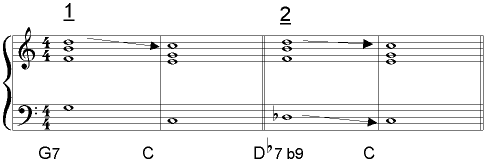How Tritone Substitutes Work
A dominant 7th chord is characterised by the tension set up in the discordant tritone interval between the 3rd and the 7th, which has a tendency to resolve to the root and 3rd of the tonic (ex 8a).

To fully understand this you should play this on a keyboard so you can listen and get a feel for the way the tension of the dominant chord is released when it resolved to the tonic.
Listen especially to how the B seems to want to lead up to the C, and how the F seems to want to lead down to the E. We call this voice leading
(In the example above not all the chord tones are present, just the bare necessities so you can more easily hear and understand this very important process.)
Original derivation
A b5 substitute is derived by chromatically altering the fifth (ex 8b) and inverting it. Think of this in stages:
- Flatten the 5th of the chord. This chord is known as flat five or flattened fifth.
- Now make the flattened 5th the bottom of the chord. You can think of this as a second inversion of the chord.
- However instead of a second inversion of D7b5, you could also consider the Ab note as a root, in which case if you enharmonically change the names of some notes it can spell out an Ab7 b5 (Ab, C, D, Gb)

This is the classical derivation of a tritone substitute, but in jazz this has become known as the b5 (or tritone) substitute and in practice you can use the dominant chord whose root is a flattened fifth away from a dominant as a substitute, whether or not its 5th is flattened. The important consideration is not its classical derivation but the fact that it shares the all important tritone (C/F# in the case of D7/Ab7) with its substitute. Note that in this it is fine to allow a change in enharmonic spellings.
Because of the tritone the two most important notes of any dominant chord are the 3rd and 7th, (Apart from the root which obviously defines the root of the chord).
Note that the same tritone is present in every pair of V7 chords whose roots are a tritone apart. (ex 8c)

ex 8c: Matching tritones in b5 substitutes.
Limitations
You should be aware that tritone substitutes may not sound so good if the melody is on the 5th or 9th of a V7 chord due to the altered tendency of the newly created chord. For example the 5th of a dominant 7 chord may have a tendency to resolve down a whole tone to the tonic (ex 8d-1, but the natural tendency of a b9 (where the melody will be if a b5 substitute is created – ex 8d-2) is to resolve down or sometimes up by a semitone.

ex 8d: Incorrect use of tritone substitution, the D in example 1 is perfectly happy resolving down a whole tone to the C, however in example 2 this resolution sounds wrong partly because of a b9 tendency to resolve by a semitone as mentioned, but also due to the conflict with the Db in the root resolving down a semitone to C.
In a cycle of fifths (ex 8e-1), if every alternate V7 is substituted by a b5 substitute the result is a chromatic cycle (ex 8e-2)

ex 8e: Chromatic root movement created by tritone substitutes on alternate chords of a cycle of fifths.